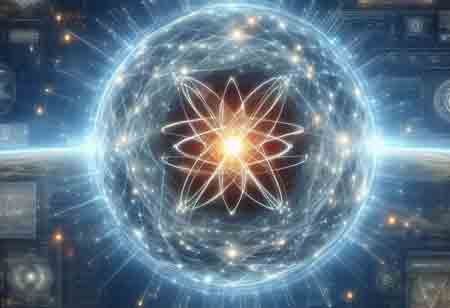THANK YOU FOR SUBSCRIBING
Be first to read the latest tech news, Industry Leader's Insights, and CIO interviews of medium and large enterprises exclusively from Applied Technology Review
Exploring the Dynamics and the Significance of Piezoelectric Ceramics
Piezoelectricity is a remarkable property of certain materials that enables the conversion of mechanical energy into electrical energy and vice versa.

By
Applied Technology Review | Tuesday, November 14, 2023
Stay ahead of the industry with exclusive feature stories on the top companies, expert insights and the latest news delivered straight to your inbox. Subscribe today.
Summary: The impact of piezoelectric ceramics spans everyday applications, such as inkjet printers, to critical fields like medical imaging and military sonar systems.
FREMONT, CA: Piezoelectricity is a remarkable property of certain materials that enables the conversion of mechanical energy into electrical energy and vice versa. Piezoelectric ceramics are a prominent class of materials that exhibit this peppery. When subjected to mechanical stress, like pressure or vibration, these ceramics generate an electric charge, making them invaluable in various applications, from ultrasound imaging and sensors to precision actuators. This unique capability has positioned piezoelectric ceramics as crucial components in modern technology, with their ability to efficiently harvest and manipulate energy, making them a cornerstone of innovation in fields ranging from healthcare to industrial automation.
The piezoelectric effect occurs when the electric charge domains within the piezoelectric material shift due to applied stress. Additionally, piezoelectric materials exhibit the inverse piezoelectric effect, changing their shape when subjected to an electric field. This inverse property arises from the external electric field, causing the material's positive and negative charge regions to move apart.
Piezoelectric materials find applications in various household products like inkjet printers and quartz watches and industrial equipment such as sound generators and detectors. Quartz and topaz are naturally occurring examples of piezoelectric materials. However, synthetic ferroelectric ceramics offer stronger piezoelectric properties and are more cost-effective, making them the preferred choice in the industry. As a result, ceramic piezoelectric materials have been extensively embraced by various sectors.
Piezoelectric Ceramics
The piezoelectric ceramics are composed of crystalline structures, such as lead zirconate titanate (PZT) or barium titanate, that exhibit piezoelectric properties. When subjected to mechanical pressure or vibrations, they generate an electric charge, making them valuable for various applications, including sensors, actuators, and energy harvesting devices. Conversely, piezoelectric ceramics deform when an electric field is applied, enabling their use in precise control systems and piezoelectric transducers.
Lead Zirconate Titanate (PZT): PZT, with highly prevalent piezoelectric ceramic properties, constitutes a solid amalgamation of lead zirconate (PbZrO3) and lead titanate (PbTiO3). The formulation of PZT allows for precise adjustments, facilitating the optimisation of its piezoelectric characteristics tailored to diverse applications. Notably, PZT ceramics demonstrate elevated piezoelectric coefficients, rendering them well-suited for a spectrum of purposes, including sensors, actuators, and transducers.
Barium Titanate: It is a perovskite crystal structure and holds historical significance as the earliest material to display piezoelectric properties, finding diverse applications in fields such as sonar devices and capacitors. Its unique crystalline arrangement contributes to its efficacy in transforming mechanical stress into electrical charges, rendering it instrumental in various technological advancements and devices. Notably, the material's application in sonar technology underscores its pivotal role in acoustic sensing and signal processing. Additionally, its use in capacitors highlights its utility in energy storage and electronic circuitry.
Lead Metaniobate: PbNb2O6 stands out as a piezoelectric ceramic endowed with distinctive attributes, notably a heightened Curie temperature. This material frequently applies in scenarios demanding elevated temperatures, wherein alternative piezoelectric substances exhibit suboptimal performance.
Applications of Piezoelectric Ceramics
Sensors: Piezoelectric sensors have extensive applications in measuring pressure, acceleration, and force. Specifically, in accelerometers, these sensors utilise piezoelectric ceramics to produce electrical signals directly proportional to the applied acceleration. This characteristic enables the acquisition of highly accurate measurements, making accelerometers integral components in various devices, ranging from automotive airbags to industrial machinery.
Actuators: Their capacity to undergo nanometer-level deformation proves highly advantageous in various technological domains. One notable example is their utilisation in inkjet printers, where the need for accurate ejection of minute droplets of ink demands a mechanism capable of achieving such precision.
Medical Devices: Their pivotal role lies in their capacity to emit ultrasonic waves when exposed to electrical voltage. This emission, coupled with their capability to receive and interpret reflected waves, facilitates the generation of intricate and detailed images depicting internal anatomical structures within the human body. This technological application underscores the indispensable contribution of piezoelectric ceramics to advancing the precision and depth of medical diagnostics through ultrasound imaging.
Energy Harvesting: Piezoelectric materials play a crucial role in energy harvesting devices, where they convert mechanical vibrations or movements into electrical energy. This innovative technology has been extensively investigated for its application in powering compact electronic devices and sensors situated in remote locations where conventional power sources prove impractical.
Sonar Technology: In underwater applications, the utilisation of piezoelectric ceramics proves pivotal for the generation and reception of acoustic signals within sonar systems. The intrinsic capacity of these ceramics to convert electrical signals into acoustic waves, and vice versa, renders them indispensable in the domain of naval and marine technologies. Their application in such contexts underscores their significance in facilitating effective communication and detection mechanisms beneath the water's surface.
Soft vs Hard Piezoelectric Materials
Soft and hard piezoelectric materials are two distinct classes of materials that generate electric charge in response to mechanical stress or vice versa. Their main difference lies in their mechanical and electrical characteristics, making them suitable for different applications.
Soft Piezoelectric Materials
Their flexibility and high piezoelectric coefficients characterise soft piezoelectric materials. These materials easily deform or bend in response to applied mechanical stress. They often comprise organic polymers, such as polyvinylidene fluoride (PVDF) or composite materials. These materials are particularly advantageous in applications that require sensitive and responsive sensors or transducers.
The essential advantage of these soft materials is their flexibility, allowing them to conform to various shapes and surfaces. This property makes them ideal for applications like pressure sensors, touchscreens, and biomedical devices. Additionally, they are generally lightweight and easy to manipulate, making them suitable for wearable technology and other portable devices.
Hard Piezoelectric Materials
Hard piezoelectric materials, in contrast, are more rigid and have lower piezoelectric coefficients than soft materials. They are often crystalline materials, like PZT or barium titanate. Hard piezoelectric materials are prized for their durability and ability to withstand high mechanical stress and extreme environmental conditions.
These materials are commonly used in applications that require high power output, such as ultrasonic transducers, actuators, and structural health monitoring systems. Their rigid nature and robustness make them suitable for industrial and automotive applications.
Piezoelectric ceramics are remarkable materials that have reshaped technology by providing a seamless interface between mechanical and electrical domains. From everyday applications like inkjet printers to critical medical imaging devices and military sonar systems, the impact of piezoelectric ceramics is profound.
I agree We use cookies on this website to enhance your user experience. By clicking any link on this page you are giving your consent for us to set cookies. More info








